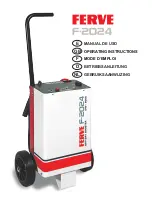
5-9
5
KM458A
3. Turn the ignition switch to the ON position. The
meter must read battery voltage.
NOTE: If battery voltage is not shown on the
meter, troubleshoot the battery connections,
ground connections, and starter cable connec-
tions.
4. With the transmission in neutral, depress the
starter button. There should be an audible “click”
from the starter relay and the meter should show 0
DC volts. If the meter indicates as specified,
replace the starter. If there is no audible click and
meter reads battery voltage, proceed to step 5.
5. Disconnect the two-wire connector on the starter
relay pigtail from the main harness; then on the
harness side, connect the red tester lead to the yel-
low/red wire and the black tester lead to the yel-
low/green wire.
6. With the transmission in neutral, depress the
starter button. The meter must read battery volt-
age. If battery voltage is indicated, replace the
starter solenoid. If no voltage is indicated, trouble-
shoot the gear position switch, starter button, igni-
tion switch, or harness connectors.
CDI Unit
The CDI is located beneath the seat at the rear of the
gas tank.
NOTE: The CDI unit is not a serviceable compo-
nent. If the unit is defective, it must be replaced.
The CDI is rarely the cause for electrical problems;
however, if the CDI is suspected, substitute another
CDI unit to verify the suspected one is defective.
NOTE: Prior to replacing the CDI unit to assure
the CDI unit is defective, it is advisable to perform
a CDI peak voltage test (see Ignition Coil in this
section) and/or perform a continuity test of the wir-
ing harness from the CDI connector to the CDI
unit.
Regulator/Rectifier
The regulator/rectifier is located on the right side of
the frame above the rear wheel. Verify all other charg-
ing system components before the regulator/rectifier is
replaced.
TESTING
1. Start the engine and warm up to normal operating
temperature; then connect a multimeter to the bat-
tery as follows.
2. Select the DC Voltage position; then connect the
red tester lead to the positive battery post and the
black tester lead to the negative battery post.
3. Start the engine and slowly increase RPM. The
voltage should increase with the engine RPM to a
maximum of 15.5 DC volts.
NOTE: If voltage rises above 15.5 DC volts, the
regulator is faulty or a battery connection is loose
or corroded. Clean and tighten battery connec-
tions or replace the regulator/rectifier. If voltage
does not rise, check Voltage (Stator Coil - No Load)
sub-section. If charging coil voltage is normal,
replace the regulator/rectifier.
Start-in-Gear Relay
NOTE: The relay schematic is embossed on the
relay housing for testing continuity.
NOTE: The module and wiring harness are not a
serviceable component and must be replaced as
an assembly.
TESTING
The start-in-gear relay is located under the seat below
the fuse block. To test the relay, use the following pro-
cedure.
1. Turn the ignition switch to the ON position; then
compress the brake lever or depress the auxiliary
brake pedal. There should be an audible “click”
from the start-in-gear relay.
NOTE: The brakelight should illuminate when-
ever either brake is applied. If the brakelight does
not illuminate, troubleshoot the respective brake-
light switch.
2. Apply the opposite brake from step 1. There should
be an audible “click” from the start-in-gear relay.
Back to TOC
Back to Section TOC
Next
Back
FOR ARCTIC CAT ATV DISCOUNT PARTS CALL 606-678-9623 OR 606-561-4983
www.mymowerparts.com
















































